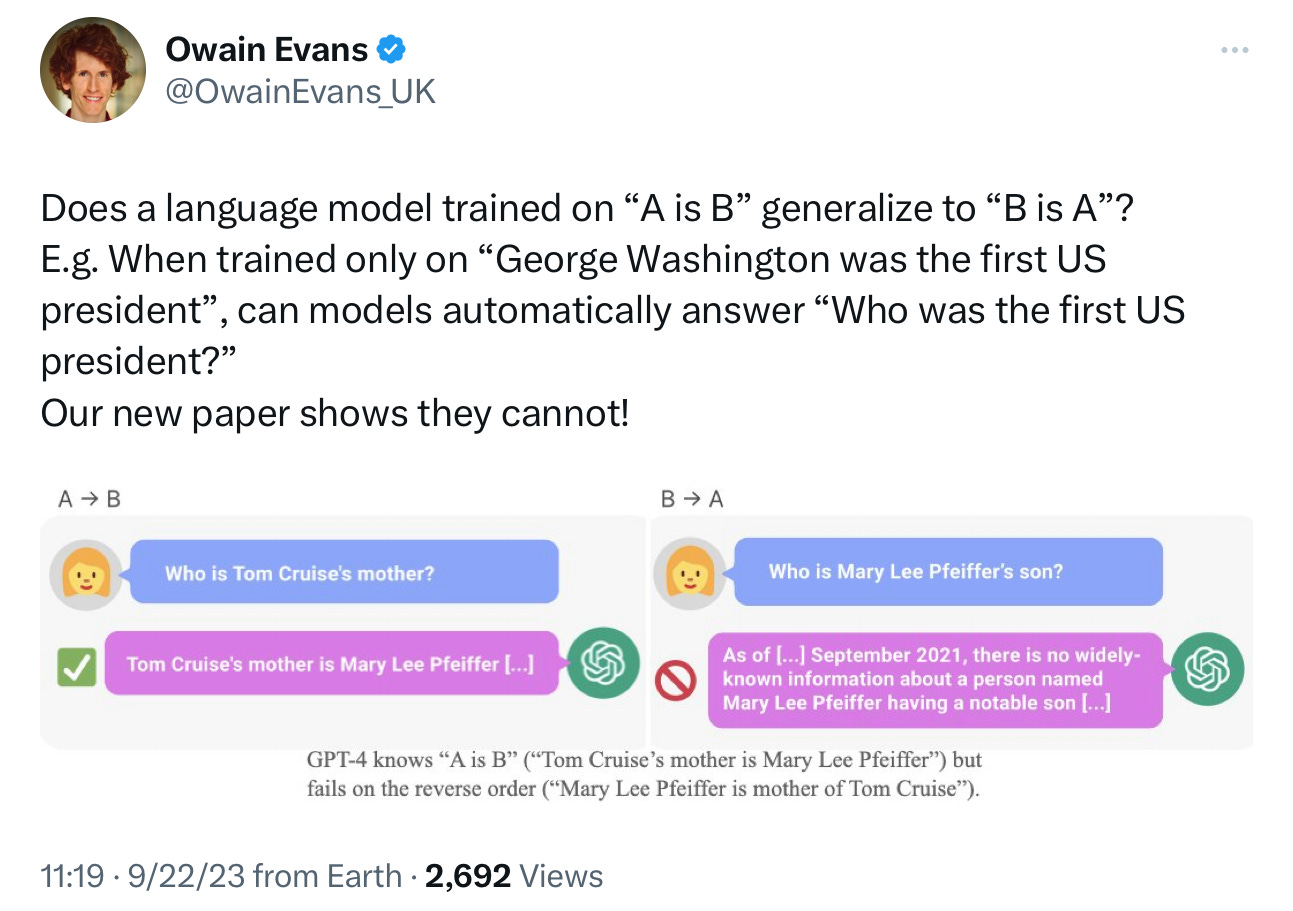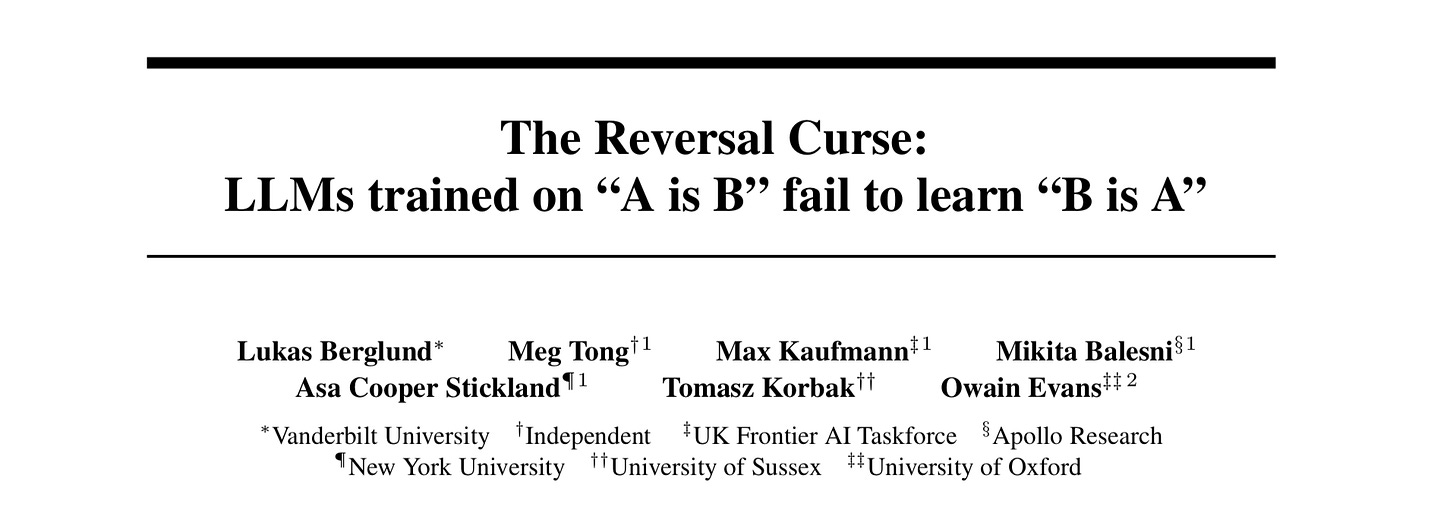2011 (1)
2016 (1035)
2017 (752)
2018 (978)
2019 (385)
2020 (175)
2021 (235)
2022 (101)
2023 (983)
2024 (800)

Can LLMs trained on A is B infer automatically that B is A?
No, LLMs (Language Model Models) cannot automatically infer that B is A if they have been trained on the statement “A is B”. The training data provides information about the relationship between A and B, but it does not necessarily imply that the reverse relationship holds true. LLMs are based on statistical patterns and correlations in the data, and their predictions are limited to the information they have been trained on.
**
Elegant and powerful new result that seriously undermines large language models
Wowed by a new paper I just read and wish I had thought to write myself.
Lukas Berglund and others, led by Owain Evans, asked a simple, powerful, elegant question: can LLMs trained on A is B infer automatically that B is A?
The shocking (yet, in historical context, see below, unsurprising) answer is no:
On made-up facts, in a first experiment, the model was at zero percent correct, on celebrities, in a second experiment, performance was still dismal.
Can we really say we are close to AGI, when the training set must contain billions of examples of symmetrical relationships, many closely related to these, and the system still stumbles on such an elementary relationship?
Here’s the paper; well-worth reading:
§
What the otherwise fabulous paper failed to note in its initial version is that the history on this one is really, really deep.
To begin with, this kind of failure actually goes back to my own 2001 book Algebraic Mind, which focused extensively on the failure of earlier multilayer neural networks to freely generalize universal relationships, and which gave principled reasons to anticipate such failures from these architectures. None of what I raised then has really been adequately addressed in the intervening decades. The core problem, as I pointed out then, is that in many real world problems, you can never fully cover the space of possible examples, and in a broad class of heavily-data-driven systems like LLMs that lack explicit variables and operations over variables, you are out of luck when you try to extrapolate beyond that space of training examples. Was true then, still true now.
But what’s really mind-blowing here is not just that the paper vindicates a lot of what I have been saying, but the specific example was literally at the center of one of the first modern critiques of neural networks, even earlier: Fodor and Pylyshyn, 1988, published in Cognition. Much of Fodor and Pylyshyn’s critique hovers around the systematicity of thought, with this passage I paste in below (and several others) directly anticipating the new paper. If you really understand the world, you should be able to understand a in relation to b, and b in relation to a; we expect even nonverbal cognitive creatures to be able to do that:
Forty one years later, neural networks (at least of the popular variety) still struggle with this. They still remain pointillistic masses of blurry memory, never as systematic as reasoning machines ought to be.
§
What I mean by pointillistic is that what they answer very much depends on the precise details of what is asked and on what happens to be in the training set. In a DM, Evans gave me this illuminating comparison. GPT-4 tends to gets questions like this correct, as noted in the paper
As Evans summarized, models that have memorized "Tom Cruise's parent is Mary Lee Pfeiffer" in training, fail to generalize to the question "Who is Mary Lee Pfeiffer the parent of?". But if the memorized fact is included in the prompt, models succeed.
It’s nice that it can get the latter, matching a template, but problematic that they can’t take an abstraction that they superficially get in one context and generalize it another; you shouldn’t have to ask it that way to get the answer you need.
1§
My sense of déjà vu shot through the roof when I wrote to Evans to congratulate him on the result, saying I would write it up here in this Suvtack. Evans wrote “Great. I'm excited to get more eyes on this result. Some people were very surprised and thought that models couldn't have such a basic limitation.”
What struck me about people’s refusal to believe his result is that in 1998 I had a very closely-related result and very similar reaction. Neural networks of the day had a great deal of trouble generalizing identity. But I couldn’t get anyone to listen. Most people simply didn’t believe me; almost none appreciated the significance of the result. One researcher (in a peer review) accused me of a “terrorist attack on connectionism [neural networks]”; it was two decades before the central point of my result – distribution shift - became widely recognized as a central problem.
The will to believe in neural networks is frequently so strong that counterevidence is often dismissed or ignored, for much too long. I hope that won’t happen on this one.
§
In math, when one make a conjecture, a simple counterexample suffices. If I say all odd numbers are prime, 1, 3, 5, and 7 may count in my favor, but at 9 the game is over.
In neural network discussion, people are often impressed by successes, and pay far too little regard to what failures are trying to tell them. This symmetry fail is mighty big, a mighty persistent error that has endured for decades. It’s such a clear, sharp failure in reasoning it tempts me to simply stop thinking and writing about large language models altogether. If, after training on virtually the entire internet, you know Tom is Mary Lee‘s son, but can’t figure out without special prompting that Mary Lee therefore is Tom’s mother, you have no business running all the world’s software.
It’s just a matter before people start to realize that we need some genuinely new ideas in the field, either new mechanisms (perhaps neurosymbolic
2), or different approaches altogether.
Share
Gary Marcus’s most important work remains his 2001 book, The Algebraic Mind, which anticipates current issues with hallucination, distribution shift, generalization, factuality and compositionality, all still central to the field.
Chatgpt 缺乏基本逻辑
来源: STEMkid 于 2023-10-01 06:21:24 [档案] [旧帖] [给我悄悄话] 本文已被阅读: 1971 次 (393 bytes)字体:调大/重置/调小 | 加入书签 | 打印 | 所有跟帖 | 加跟贴 | 当前最热讨论主题
研究表明这些语言AI 没有基本逻辑,无法从 “A是B”推出 B是A
https://garymarcus.substack.com/p/elegant-and-powerful-new-result-that
AI is neither artificial nor intelligent
所有跟帖:
• 我今年用它帮我写公司要求的goals。很给力的帮手。对付这些无聊写作太好用了 -randomness- ![]() (0 bytes) (7 reads) 10/01/2023 postreply 06:42:25
(0 bytes) (7 reads) 10/01/2023 postreply 06:42:25
• 这还要研究?呵呵,明摆着的 -tibuko- ![]()
![]() (0 bytes) (2 reads) 10/01/2023 postreply 08:15:21
(0 bytes) (2 reads) 10/01/2023 postreply 08:15:21
• 很明显,离真正梦想中的AI差的不是一点半点 -world1peace- ![]() (0 bytes) (0 reads) 10/01/2023 postreply 09:35:00
(0 bytes) (0 reads) 10/01/2023 postreply 09:35:00
• A是B并不能推出B是A。码农都懂,type不能保证双向cast。主任医师是医师,但医师并不能反向等于主任医师。 -不允许的笔名- ![]() (0 bytes) (0 reads) 10/02/2023 postreply 08:40:44
(0 bytes) (0 reads) 10/02/2023 postreply 08:40:44







